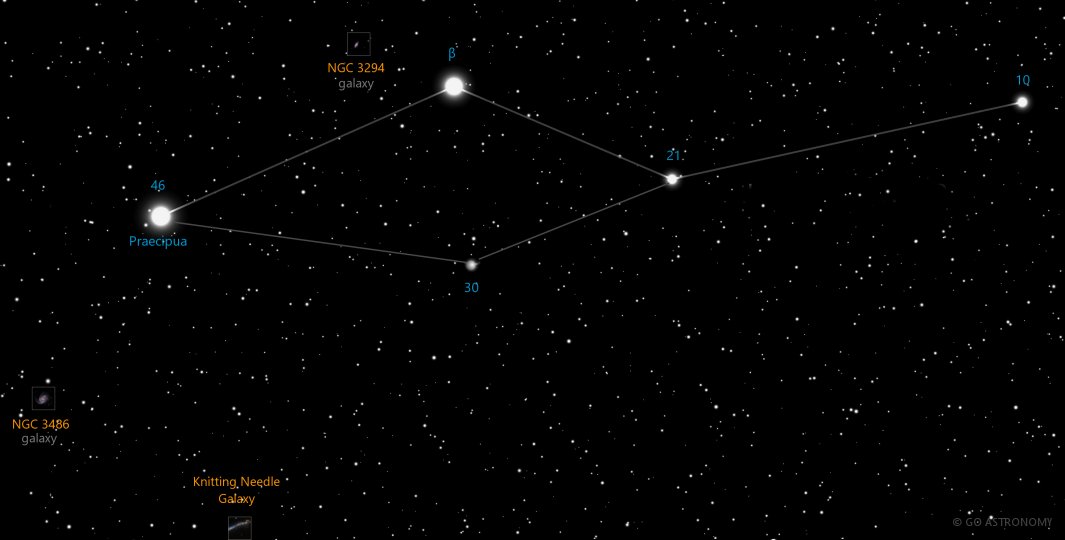Leo Minor, the Lesser Lion (LMi)
(LEE-oh MY-ner)
The Northern constellation of Leo Minor, the Lesser Lion, is best viewed in Spring during the month of April.
Leo Minor is the 64th largest constellation. It's brightest star is Praecipua at magnitude 3.83. The boundary of the Leo Minor constellation contains 2 stars that host known exoplanets.
- Pronunciation:
- LEE-oh MY-ner
- Meaning:
- Lesser Lion
- Genitive:
- Leonis Minoris
- Abbreviation:
- LMi
- Constellation Family:
- Ursa Major
- Hemisphere:
- Northern
- Quadrant:
- NQ2
- Visibility:
- 90° N - 45° S
- Best viewing month*:
- April
- Area:
- 232 sq. degrees
- Size:
- 64th largest
- Right Ascension (avg):
- 10h 19m
- Declination (avg):
- 33°
- Brightest star:
- Praecipua (3.83)
- Stars with planets:
- 2
- Messier objects:
- |
- Caldwell objects:
- |
Brightest Stars in Leo Minor
The 10 brightest stars in the constellation Leo Minor by magnitude.
- Star
- Magnitude
- Spectral class
- 46 Leo Minoris (46 LMi)
- 3.79
- K0III-IV
- Beta Leo Minoris (β LMi)
- 4.2
- G8III-IV
- 21 Leo Minoris (21 LMi)
- 4.49
- A7V
- 10 Leo Minoris (10 LMi)
- 4.54
- G8III
- 37 Leo Minoris (37 LMi)
- 4.68
- G0II
- 30 Leo Minoris (30 LMi)
- 4.72
- F0V
- 41 Leo Minoris (41 LMi)
- 5.08
- A3Vn
- 19 Leo Minoris (19 LMi)
- 5.11
- F6Vs
- 42 Leo Minoris (42 LMi)
- 5.36
- A1Vn
- 20 Leo Minoris (20 LMi)
- 5.37
- G1V
Galaxies in Leo Minor
The most notable galaxies in the constellation Leo Minor. Also see all galaxies.
The Lesser Lion Constellation
Leo Minor, the Lesser Lion, is a small and faint constellation in the northern celestial hemisphere. While it is less famous than its larger neighbor, Leo, it still offers astronomers and stargazers interesting points of interest and a unique history.
Historical Overview
Unlike many of the other 88 recognized constellations, Leo Minor does not have roots in ancient civilizations. It was introduced by the Polish astronomer Johannes Hevelius in the 17th century, who felt the space in the sky between Leo and Ursa Major ought to be filled. The constellation does not have any associated myths or stories from the ancient world.
Location and Main Features
Leo Minor is found in the second quadrant of the northern hemisphere (NQ2), and can be seen at latitudes between +90? and -45?. It is bordered by the constellations of Ursa Major, Lynx, Cancer, and Leo. With an area of 232 square degrees, it ranks 64th in size among the 88 modern constellations.
Major Stars
Leo Minor does not contain any particularly bright stars. Its brightest, 46 Leonis Minoris (also known as Praecipua), has an apparent magnitude of 3.83 and is located about 98 light-years away from us. This giant orange star, approximately 320 times as luminous as our sun, represents the lion's chest.
The constellation's second brightest star, 21 Leonis Minoris, is a yellow-white F-type main-sequence star located approximately 92 light-years away. The star has an apparent magnitude of 4.49 and is around 4.5 times the size of our Sun.
Deep Sky Objects
Despite its faintness and small size, Leo Minor hosts a few deep-sky objects. These include several faint galaxies, the brightest of which is the barred spiral galaxy NGC 3344. This galaxy is located approximately 20 million light-years away and has an apparent magnitude of 10.5, making it a challenging object to observe for amateur astronomers.
Observation
Observing Leo Minor requires a clear, dark sky and ideally a telescope to clearly distinguish its faint stars. The constellation is best seen in late winter and early spring in the northern hemisphere. During this time, it is located halfway between the easily recognizable constellations of Ursa Major and Leo, aiding in its identification.
Leo Minor in Modern Astronomy
Leo Minor's role in modern astronomy is primarily as a reference for locating other celestial objects. Its stars are often used for navigation and calibration of telescopes, and its deep-sky objects provide opportunities for detailed study of distant galaxies. Its existence highlights the ongoing evolution of our understanding of the night sky, reminding us that the mapping and naming of constellations is a human endeavor, subject to change and growth over time.
* Constellation shown for northen hemisphere skies. For the southern hemisphere, constellations appear rotated 180 degrees (upside-down and left-right reversed) from what is shown. Remember that seasons are reversed too - summer in northern latitudes is winter in southern latitudes.
** Circumpolar constellations are visible year-round in the hemisphere listed (and not at all in the opposite hemisphere).





